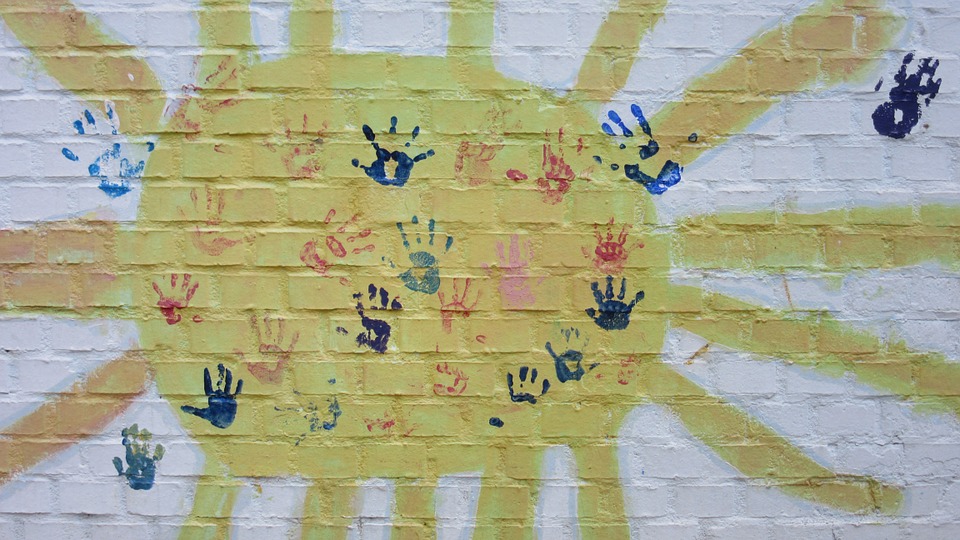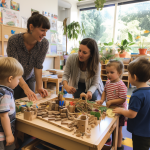Do you agree that hand and footprint art should be banned in the early years
Some are arguing that hand and footprint art has no benefits for the child and although examples of lovely art pieces can be seen on many early years sites and plans that they really have no place in the early years.

All early years practitioners will have seen examples of hand print art and footprint art and some wonderful pictures can be created by practitioners using these prints for almost any topic or occasion however is there really any benefit to the child? Should children be pulled away from meaningful and engaging play experiences to have their hands covered in paint and made to make perfect handprints so that practitioners can turn these into pictures? Some are arguing that this must stop as it only has benefits for the practitioners and for the parents and that the child is fact gains very little from these experiences. Some would say they are even causing harm by interrupting a child’s play to complete this adult led, adult motivated exercise.
What the EYFS suggests
The Early Years Foundation Stage tells us that children learn through playing and exploring, active learning, and creating and critically thinking and during handprint art there is limited opportunity for this to happen. This is because during handprint art there is a set picture or goal in mind leaving little opportunity for children to fully explore the paint and the effects it has. There is little room for active learning or creating or critically thinking as the practitioner has done all of this by having a set end product in mind for the hand or footprint.
Many would argue that children would benefit from being able to freely explore the paint with their hands and feet and make any pictures, movements and marks they desire. Allowing them to critically and creatively think about what happens when they move in certain ways or mix particular colours. Finger painting, whole body painting, painting with tools, cars, balls and natural objects all allow children to have control over what they want to create and how they want to explore making the creations truly their own.
It gives children more motivation and pride to know they have achieved a final product that looks just how they wanted it to rather than how the practitioner envisioned it should look. Younger children gain from the sensory experience and physical skills involved in using their bodies and exploring the paints how they chose and older children may begin to give meanings to their marks and often this can be lost through precise hand and footprint art.

For these reason many are choosing to ban hand and footprint art within their settings opting to create different art pieces with the children. However some decide to still us hand and footprint art as they make lovely keepsakes for special occasions and they also argue that some sensory experiences and bodily awareness are gained by the children having their hands and feet printed.
Please follow Early Years Careers on Facebook for more Early Years News







One of our boys’ favorite crafts from pre school is an “adult led” activity where they took pictures of the kids and laminated them to pumpkins to make it look like they were popping out of the pumpkins. It does not matter how much work the adults did, he believes he did the craft and he loves pulling it out every year. He feels a sense of accomplishment and pride and he loves to remember that class.
I completely disagree with this article. Children need a balance of directed and self-directed learning. I won’t share what I’m really thinking because it’s unbelievable to me that people feel they need to ban activities like this.
I completely agree. We stopped doing three years ago. What does the child gain from it? Nothing really. Ive witnessed children who are engrossed in their play pulled away from it to make this type of art. I have also seen children who clearly do not want to do it, painted and then guided to the paper just so much money and daddy can have a picture they like. As a parent I was much happier receiving something I knew my child had done independently.
Children can have plenty of sensory experiences without having to take part in a hugely adult directed activity.
What happened to young children going to nursery to have fun? It can’t all be about the curriculum. Let them be children.
This is the most ridiculous thing I have read in a while (and I read a lot). Why would you even think of dragging your kids from whatever they are doing to do a hand print?. It is up to you as a educator to choose the time for any activity. If your painting project interrupts with their “tea party” it is not worth a debate. It just shows that you should not be teaching kids.
I have some families that love having the hand prints of their kids because they can send it to relatives overseas, etc. So I just quickly take one sheet of paper away, the one with the nice hand print, and put another one in for them to then do it their own way.
I agree with the comments about the execution of the activity. When children are allowed to lead activities there is always learning happening. I think this article highlights the need for practitioner CPD and how important it is to understand why and how to scaffold children’s learning.
I think it depends on how you do it. we had children painting each others hands and feet to print and that helps develop turn taking, playing co-operatively together. Helping others, self care…..the whole adult led activity was for children to support each other in doing the prints not just the end result of the print. The children absolutely loved it and in return we got some fan prints and pictures of them doing the activity.
Whilst I understand where some people are coming from I do believe it’s not the activity people are against but the way in which it is poorly executed.
As a mother and Montessori teacher, I find that this is another example of an extreme. Projects like this can be a starting point for children who were never exposed to any sort of art “because it’s messy,” and have been criticized on their art/creative work. There are so many skills to be learned from experiences like this, and I think it can be a gateway to further exploration in creativity.
Why must everything be done for an outcome or particular benifit?! Why can it not just be done for fun? Kids LOVE painting their hands and feet! They also LOVE seeing what it looks like, whether you paint print it or draw around their fingers!
We need to stop trying to analise EVERYTHING and let children do things that make them happy, like hand and foot prints…..
disagree, the values taught and experiences out weighs any negative. kids like to explore textures, color mixing, self help skills taking own socks off washing feet and hands. learning how colors go together, math hands growing, sizes how many etc, science, social all this and more. keep on painting and using hands and feet. teach on??
You are absolutely right! The article does try to highlight that there are these benefits from hand and foot print painting. The article more aims to highlight how these benefits can be removed when practitioners do not give the children the opportunities to discuss and discover these things by becoming to fixated on the end product of a ‘perfect hand print’ for example for a card.
I strongly disagree with banning this altogether. I use hand and foot prints in my pre-school room for such things as all about me, we look at different sizes of hands and feet, we can measure them and look at similarities. We can record the size, writing numbers down, ordering them by size and the child has a sense of self, seeing their print proudly displayed. I have also used footprints on the floor to make an obstacle course, helping guide the children around or help them build one themselves. I think people need to look outside the box instead of being tunnel visioned on “disturbing play”, choose your time wisely and a simple sensory experience of painting a hand or a foot can be widely used across the EYFS.
I think most people are missing the important points of this article. There are valuable benefits to the child by exploring paint with hands, feet and other parts of the body and making prints. I agree that children gain nothing when the adult turns this experience into one with an end-product which is unrealistic for the young child to achieve. The spider, Santa, angel, tree handprints etc are churned out at every occasion. I did the Santa handprints as part of an experiment with my friend’s 4-year old to see exactly what she got out of it. After several processes, the one that looked ‘the way it should’ was the one I had 99% of the input. The one that looked the most individual and, in both the child and my opinion, the best was the one the child had 100% input – painted freely with a brush and finger marks in places. This is not a trivial matter, it’s important if we want to nurture a creative generation of children to be confident, resilient and innovative adults. As everyone has said before, we are all entitled to our own opinions. Great article for debate.
Yet another stupid thing being debated when there is no need. Everything the kids do is a learning experience and even if the hand or feet print have an end project led by the adult the children can learn that a leader and their team can work together to produce something wonderful.
This world is really pushing my patience and wish we could go back in time and let children be children!!!!!
The Early Years is full of debate Moira and everyone is entitled to their opinion 🙂 As stated in the article there are some benefits to this activity, especially if the child is given control over the process. It explains that simply taking a child away and painting their hands to create a print then cleaning them up and sending them off to play limits the experience for the child.
I give my children huge sheets of paper (outside) lots of different colour paints, brushes, sponges etc then leave them to it. Within a couple of seconds hands,arms,faces are covered in paint then using the bowl of warm waster they wash off and start again the paper end up soggy with paint and water but that’s part of the fun. No perfect hand and feet printing here just playing and exploring because it’s ‘great fun’
This sounds like a great way for the children to take charge of the activity and make it their own experience 🙂
This is exactly why I can’t wait to leave early years. Stupid stuff like this. It doesn’t scar them for life! It’s a hand print which actually promotes shape, space and measure if you take one a year and look at the size difference. This would also encourage an understand of time and how things can change over time.
But instead of actually thinking of ways to expand children’s development and make what little childhood they are actually allowed count we are adding things that can be fun and educational to the ban list because a few people don’t think about how they are possibly impacting on play.
Hand and footprint art is a lovely way for the children to see how their bodies are changing, you are completely right. The article is explaining the impact that can be had on a child’s experience if they are taken away from another activity that they are fully engaged in. Using their bodies to create art is very fulfilling for the children if they are able to take charge of the activity for themselves 🙂
I totally agree with this article, process not product , in the long run it does not help children be creative and enjoy mark making when they are constantly making fully formed images and being involved in adult lead play. Saw it all the time as an art teacher, children who were obsessed with the end image looking ‘realistic’ and who could not let go and enjoy the process
A great way to explain the meaning of the article Chloe! It really is all about getting involved and enjoying the creating rather than worrying about how the art looks at the end 🙂
Can hands and feet not part of the process? I totally agree that it is about the process rather than the end product. But I dont think any pratictioner would limit this type of painting to just hands and feet. It is about the whole experience for the child.
You are right Amy, the activity can open up a range of experiences for a child. The article talks about how the child should lead the experience rather than the adult, which rings true for many activities.
A load of old crap .no child is taken away from anything important to do the prints .the time is allocated for it plus the kids have a ball mushing their little hands and feet in a new texture god what next.you dont have to be an expert to know any of this…
Both as a mum and a childminder I think this is ridiculous. I still have and always will pictures my own children did when they were younger and they hold great memories of their younger years and we often get them out and look through them re living the times etc. As a childminder my parents love our hand prints crafts and what We make using them. The older children love Creating their own designs and getting very messy and showing them off to parents. we use the pictures to count their fingers, learn left and right etc aswell so they help them learn in a very fun and unique way to them.
I can also understand when children only ever do hand print crafts and is nice for children to create their own unique style and creations but you can let children do both ways aswell. I do slot of child led activities but sometimes hand print ones are good memories etc
As I work in a nursery hand and foot prints isn’t something we usually display but the children choose to paint their own hands when painting. So this is something you can’t really ban from childcare setting as the children have a choice in what they do and no one can take that freedom away from them
I think this is crazy. There is alot of descriptive language used. It also encourages independence, taking off own socks and shoes. It also helps to get the children to paint the other children’s feet helping with holding a paintbrush. Early Maths is also involved, counting feet, counting toes, comparing size of feet, talk about length. You can also point out the parts of the foot. There is so much going on, its ridiculous to say there is no benefits involved.
Good, valid points.
Why can’t the children just have fun does fun not have a place in EYFS they learn that any part of the body can be used as well as tools and children usually help practitioners to decorate the prints in my experience children learn more when having fun at the same time they actually look forward to doing it
This activity totally depends in how you choose to evaluate it’s benefits/outcomes…. Is it sensory? Is it encouraging use of language, or understanding of language? A good practitioner will let the child lead the way… And then evaluate the outcome… Maybe we get to hung up on measuring child initiated and child let activities… No right or wrong about this as long as it’s fun and only voluntary participated in or encouraged…but not forced upon a child….
Just my opinion and we are all encouraged to have one…a bit like making choices…is it the right one??
I disagree, I think all sensory experiences should be valued. I have known many children cover their hands in paint using a brush or dipping their hands in the paint pallet on their own without adult directed play.
I equally think it is important for children to feel valued and remembered by paintings within their family, I myself have a handprint and footprint painting of my own which has been kept and I can even remember this being done and it’s a very positive memory- laughing as the paint tickled my feet.
So for these reasons I will been continuing hand ands footprint paintings within my children’s centre setting.
How ridiculous to even think of banning prints.
It can cover all areas of the EYFS. Children would rather use there hands to explore media, I have lost count how many times I have gone home with handprints on my trousers! Children get great pleasure seeing distinguishing marks they can make and nothing better then a personal significant meaning!
I agree with you children love putting their hands in paint and other messy activities they are exploring sensory and love seen their own marks they make with their hands
I totally strongly disagree with this as we do alot hand and foot art craft activities it has has great sensory experience to the children in my setting also we give all the children the chose to do it or not they also build there confidence and self-esteem taking great pride in completed work what next will they band
Sounds like you are completing these activities in a very beneficial way. The main purpose of this article was to highlight how sometimes practitioners can become too fixated on the end result during hand and footprint craft and it becomes like a conveyor belt of taking prints, rather than a beneficial activity.